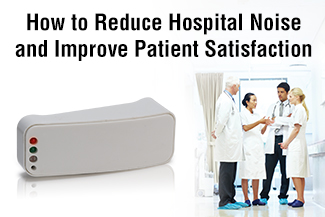So your hospital has a noise problem. It jeopardizes your patients’ health and satisfaction as well as your survey-based reimbursement dollars. You need to improve your “Quiet at Night” HCAHPS scores to protect your funding, but you don’t know where to begin.
You’ll be happy to know that there is a solution.
Creating a culture of quiet is not as easy as replacing a creaky cart or asking night shift to lower their voices. Only a coordinated, data-based approach with system-wide commitment will ensure success. That means investing both physically and financially in your new noise management strategy.
Now, that might sound difficult, especially if your time and money are stretched thin as it is. The good news is our system is designed to place the least possible amount of burden on your leadership team.
ComfortZone by Quietyme uses a non-invasive, state-of-the-art sensor and cloud-based system to help you identify, assess, and ultimately reduce problematic noise levels in your healthcare facility. It’s a sophisticated solution that doesn’t require an unreasonable amount of time to monitor and operate. In fact, we’re confident you’ll find it fits seamlessly within your workspace and workflow.
The ComfortZone method comprises the following four core components.
Establish noise limits: A hospital is not a library, and your goal should not be to make it one. Alarms and other noises are acceptable and cannot or should not be eliminated. ComfortZone establishes reasonable noise limits for key areas based on best practices and your organization’s unique circumstances. For reference, a nighttime patient room limit regarded as acceptable and attainable is 45 decibels.
Identify sources of noise disturbances: Loudspeaker paging systems, televisions, talking visitors, medical equipment, and caregiver conversations are some of the most common sources of disruptive noise. While you might have a basic handle on what is keeping your patients up at night, you need quantifiable data to effect real change. ComfortZone pinpoints the exact time and location of each sustained noise, then provides reports and alerts to identify and help you prevent future incidents. Your reports and scores will arrive daily.
Reduce unwanted noise: Once you isolate the time and location of unacceptable noise spikes, the next step is to identify what they are. Sometimes this is easy, other times not. You must be absolutely certain of noise types in order to implement effective, data-based changes. That’s where ComfortZone Success Managers come in. They are trained noise experts who can interpret the information collected from each area of your facility. They can, for example, distinguish a consistently noisy door from an accident such as a dropped tray.
Monitor for ongoing compliance: There is no miracle cure when it comes to reducing noise and improving patient satisfaction. ComfortZone equips you with the easy-to-use tools you need to create a culture of quiet. You will not find a solution this free of hassle anywhere else. Still, effective noise management requires sustained effort, communication, flexibility, and patience. Investing in a system that is tailored to the unique needs of your healthcare environment is the first step.
Thanks for reading. Do you have questions on ComfortZone and how it can help you raise your HCAHPS scores? Please leave them in the comment box below!
